Czartoryski
|
| |
| Ethnicity | Polish–Lithuanian[1]-Ruthenian[2] |
|---|---|
| Current region | Poland |
| Place of origin | Czartorysk, Polish–Lithuanian Commonwealth (since 1945 Ukraine) |
| Members |
Michał Czartoryski August Czartoryski Adam Czartoryski Adam Czartoryski Isabella Flemming |
| Connected families | Sieniawski, Poniatowski |
| Estate | Czartoryski Palace |
| motto: Bądź co bądź ("Come what may") | |
Czartoryski (feminine form: Czartoryska, plural: Czartoryscy; Ukrainian: Чарторийські, Chartoryisky; Чорторийські, Chortoryisky; Lithuanian: Čartoriskiai) is a Polish princely family of Lithuanian[3]-Ruthenian[4] origin, also known as the Familia. The family, which derived their kin from the Gediminids dynasty,[5][6] by the mid-17th century had split into two branches, based in the Klevan Castle and the Korets Castle, respectively. They used the Czartoryski coat of arms and were a noble family of the Polish–Lithuanian Commonwealth in the 18th century.
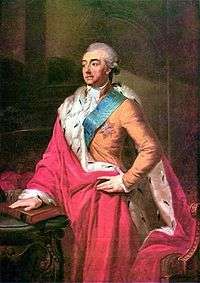
History
The Czartoryski family is of Grand Ducal Lithuanian descent from Ruthenia. Their ancestor was the Grand Duke of Lithuania Algirdas's son, known after his baptismal name Constantine (c. 1330 − 1390), who became a Prince of Chortoryisk in Volhynia.[7] One of his sons Vasyli Chortoryiski (Wasyl Czartoryski) (c. 1375 – 1416) was granted an estate in Volhynia in 1393, and his three sons John, Alexander and Michael (c. 1400 – 1489) are considered the progenitors of the family.[8] The founding members were Ruthenian and Eastern Orthodox, and then converted to Roman Catholicism during the 16th century.[8]
It was Michael's descendant Prince Kazimierz Czartoryski (1674–1741) Duke of Klewan and Zukow (Klevan and Zhukiv), Castellan of Vilnius who reawakened their royal ambitions at the end of the 17th century. An intelligent, well educated man, he married Isabella Morsztyn daughter of the Grand Treasurer of Poland and built "The Familia" with their four children, Michał, August, Teodor and Konstancja. The family became known and powerful under the lead of brothers Michał Fryderyk Czartoryski and August Aleksander Czartoryski in the late Polish–Lithuanian Commonwealth of the 18th century, during the reigns of monarchs Augustus II the Strong and Stanisław I Leszczyński. The family attained the height of its influence from the mid-18th century in the court of Augustus III of Poland. The Czartoryski brothers gained a very powerful ally in their brother-in-law, Stanisław Poniatowski, whose son became the last king of independent Commonwealth, Stanisław August Poniatowski, near the end of the century.
The Czartoryski's Familia have seen the decline of the Commonwealth and the rise of anarchy and joined to camp which was determined to press ahead with the reforms, thus they sought the enactment of such constitutional reforms as the abolition of the liberum veto.
Although the family estate at Puławy was confiscated by Russian Empire in 1794, during the third partition of Poland, the Familia continued to wield significant cultural and political influence for decades after, notably through the princes Adam Kazimierz, Adam Jerzy and Konstanty Adam.
The Czartoryski family is also renowned for the Czartoryski Museum in Kraków and Hôtel Lambert in Paris.
Today, the only descendants of Prince Adam Jerzy Czartoryski are Prince Adam Karol Czartoryski and his daughter Tamara Czartoryska who are living in the United Kingdom. The descendants of Prince Konstanty Adam Czartoryski live to this day in Poland and have their representatives in the Confederation of the Polish Nobility.
Coat of arms and motto
The Czartoryski family used the Czartoryski coat of arms and the motto Bądź co bądź ("Come what may", literally 'let be, that which will be'). The family's arms were a modification of the Pogoń Litewska arms.
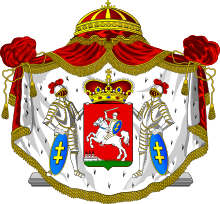 Czartoryski coat of arms used in 1785
Czartoryski coat of arms used in 1785
Notable members

Notable members include:
- Wasyl Czartoryski (died after 1416), married Hanna
- Michał Czartoryski (died before 1486), married Maria Niemir
- Teodor Czartoryski (died 1542), married Princes Zofia Sanguszko h. Pogoń Litewska
- Iwan Czartoryski (died 1566), married Princess Anna Zasławska h. Korybut
- Jerzy Czartoryski (1550−1626), married Princess Aleksandra Wiśniowiecka h. Korybut, Halszka Hołowińska h. Hołowiński and Princess Zofia Lubomirska h. Szreniawa
- Michał Jerzy Czartoryski (1585−1661), married Princess Izabella Korecka h. Pogoń Litewska
- Michał Jerzy Czartoryski (1621−1692), married Rosine Margarethe von Eckenberg, Eufrozyna Stanisławska h. Szeliga and Joanna Weronika Olędzka h. Rawa
- Kazimierz Czartoryski (1674−1741), married Countess Izabela Elżbieta Morsztyn h. Leliwa
- Michał Fryderyk Czartoryski (1696–1775), married Countess Elenora Monika Waldstein
- August Aleksander Czartoryski (1697−1782) married Countess Maria Zofia Sieniawska h. Leliwa
- Adam Kazimierz Czartoryski (1734–1823), married Izabela Czartoryska h. Fleming
- Maria Anna Czartoryska (1768−1854), married Louis, Duke of Württemberg
- Adam Jerzy Czartoryski (1770–1861), married Princess Anna Zofia Sapieha h. Lis
- Izabella Elżbieta Czartoryska (1832–1899), married Count Jan Kanty Działyński h. Ogończyk
- Witold Czartoryski (1824–1865), married Maria Cycylia Grocholska h. Syrokomla
- Władysław Czartoryski (1828–1894), married María Amparo Muñoz, 1st Countess of Vista Alegre and Princess Marguerite Adélaïde of Orléans
- Beatified August Franciszek Czartoryski (1858–1893)
- Adam Ludwik Czartoryski (1872–1937), married Countess Maria Ludwika Krasińska h. Ślepowron
- Elżbieta Czartoryska (1905–1989) married Count Stefan Adam Zamoyski h. Jelita
- Augustyn Józef Czartoryski (1907–1946), married Princess Maria de los Dolores of Bourbon-Two Sicilies
- Adam Karol Czartoryski (b. 1940), married Nora Picciotto and Josette Calil
- Tamara Czartoryska (b. 1978)
- Adam Karol Czartoryski (b. 1940), married Nora Picciotto and Josette Calil
- Konstanty Adam Czartoryski (1773–1860), married Princess Aniela Radziwiłł h. Trąby and Maria Dzierżanowska h. Gozdawa
- Jerzy Konstanty Czartoryski (1828–1912), married Maria Joanna Czermak
- Witold Leon Czartoryski (1864–1945), married Countess Jadwiga Dzieduszycka h. Sas
- Włodzimierz Alfons Czartoryski (1895–1975), married Countess Zofia Tyszkiewicz h. Leliwa
- Professor Paweł Czartoryski (1924–1999)
- Beatified Jan Franciszek Czartoryski (1897–1944)
- Roman Jacek Czartoryski (1898–1958), married Countess Teresa Janina Zamoyska h. Jelita
- Piotr Michał Czartoryski (1908–1993), married Countess Anna Zamoyska h. Jelita
- Włodzimierz Alfons Czartoryski (1895–1975), married Countess Zofia Tyszkiewicz h. Leliwa
- Witold Leon Czartoryski (1864–1945), married Countess Jadwiga Dzieduszycka h. Sas
- Jerzy Konstanty Czartoryski (1828–1912), married Maria Joanna Czermak
- Zofia Czartoryska (1780−1873), married Count Stanisław Kostka Zamoyski h. Jelita
- Elżbieta Czartoryska (1736–1816), married Stanisław Lubomirski h. Szreniawa
- Adam Kazimierz Czartoryski (1734–1823), married Izabela Czartoryska h. Fleming
- Konstancja Czartoryska (1700–1759), married Stanisław Poniatowski h. Ciołek, mother of the last King of Poland Stanisław August Poniatowski
- Kazimierz Czartoryski (1674−1741), married Countess Izabela Elżbieta Morsztyn h. Leliwa
- Michał Jerzy Czartoryski (1621−1692), married Rosine Margarethe von Eckenberg, Eufrozyna Stanisławska h. Szeliga and Joanna Weronika Olędzka h. Rawa
- Michał Jerzy Czartoryski (1585−1661), married Princess Izabella Korecka h. Pogoń Litewska
- Jerzy Czartoryski (1550−1626), married Princess Aleksandra Wiśniowiecka h. Korybut, Halszka Hołowińska h. Hołowiński and Princess Zofia Lubomirska h. Szreniawa
- Iwan Czartoryski (died 1566), married Princess Anna Zasławska h. Korybut
- Teodor Czartoryski (died 1542), married Princes Zofia Sanguszko h. Pogoń Litewska
- Michał Czartoryski (died before 1486), married Maria Niemir
Palaces
 Ruins of the Castle of Czartorysk
Ruins of the Castle of Czartorysk.jpg) Ruins of the Castle of Korets
Ruins of the Castle of Korets.jpg) Ruins of the Czartoryski Palace in Wołczyn (1898)
Ruins of the Czartoryski Palace in Wołczyn (1898)- Castle of Medzhybizh
 Ruins of the Castle of Berezhany
Ruins of the Castle of Berezhany Ruins of the Castle of Klevan
Ruins of the Castle of Klevan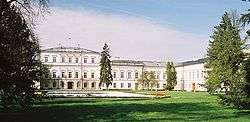 Czartoryski Palace in Puławy
Czartoryski Palace in Puławy- Czartoryski Palace in Lublin
.jpg)
- Czartoryski Palace in Sieniawa
 Konarzew Palace
Konarzew Palace Palace in Rokosowo
Palace in Rokosowo- Palace in Baszków, Łódź Voivodeship
 Palace in Pełkinie
Palace in Pełkinie- Siedlce Palace
 Palace in Międzyrzec Podlaski
Palace in Międzyrzec Podlaski
- The Blue Palace, Warsaw

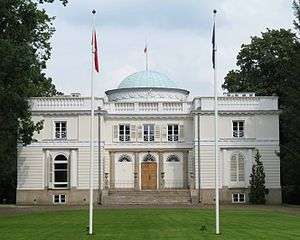 Natolin Palace
Natolin Palace- Former Czartoryski Palace in Kalwaria Zebrzydowska (rebuild)
 Temple of the Sibyl, 18th century museum in Puławy
Temple of the Sibyl, 18th century museum in Puławy
See also
- Czartoryska (disambiguation page for female members of the family)
- Princely Houses of Poland
- Familia
- Czartoryski Museum
- Royal Casket
- Czartoryski-Schlössel
- Hôtel Lambert
- Princes Czartoryski Foundation
References
- ↑ The Encyclopedia Americana–A Library of Universal Knowledge, Volume 23. Encyclopedia Americana Corporation. 1919. p. 131.
- ↑ Lerski, Jerzy Jan (1996). Historical Dictionary of Poland, 966-1945. Greenwood Publishing Group. p. 94. ISBN 0313260079.
- ↑ Bain, R. Nisbet (2013). Slavonic Europe : a political history of Poland and Russia from 1447 to 1796. Cambridge University Press. p. 382. ISBN 9781107636910.
- ↑ Lerski, Jerzy Jan (1996). Historical Dictionary of Poland, 966-1945. Greenwood Publishing Group. p. 94. ISBN 0313260079.
- ↑ Galkus, Juozas (2009). The Vytis of Lithuania. Vilnius: Vilnius Academy of Arts press. p. 42. ISBN 9789955854449.
- ↑ Łowmiański, Henryk (1998). Zaludnienie państwa litewskiego w wieku XVI : zaludnienie w roku 1528. Poznań: Wydawn. Poznańskie. p. 42. ISBN 9788386138371.
- ↑ Tęgowski J. Który Konstanty — Olgierdowic czy Koriatowic — był przodkiem kniaziów Czartoryskich? // Europa Orientalis. — Toruń, 1996. — S. 53-59.
- 1 2 Jerzy Jan Lerski, Piotr Wróbel, Richard J. Kozicki (1996). Historical dictionary of Poland, 966-1945. Greenwood Publishing. p. 94. ISBN 978-0-313-26007-0.
External links
-
 Media related to Czartoryski family at Wikimedia Commons
Media related to Czartoryski family at Wikimedia Commons - Czartoryski at the Encyclopedia of Ukraine

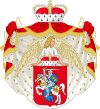
.svg.png)